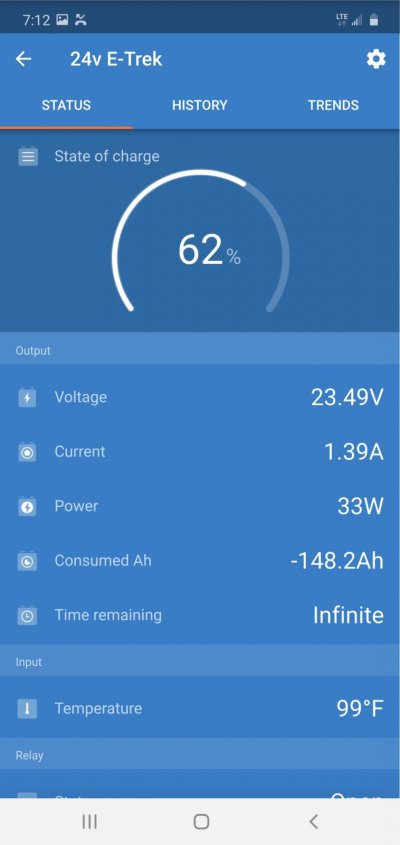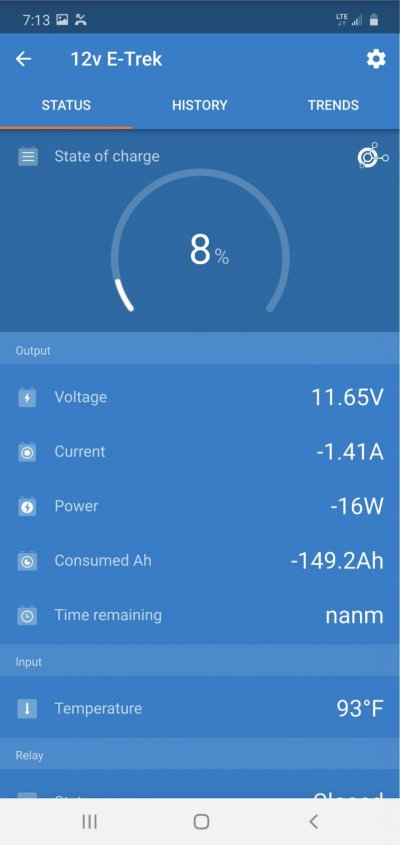There have been several discussions on Victron monitors, installing, using, etc lately but little discussion about how to know what the monitor is telling you and/or what it is not.
The Victron 712 Smart seems be getting popular because of the Blue Tooth to phones, so I looked up the manual for it recently.
https://www.victronenergy.com/upload/documents/Manual-BMV-700-700H-702-712-EN-NL-FR-DE-ES-SE.pdf
The biggest question to me was what the default values in monitor as shipped were, as that will be a huge determiner of how good the information is that you get out of it. We have heard that the monitor only really asks for battery bank 20 hr capacity, and that the defaults are good to use as is, so looked for the actual numbers.
Here is what it says in the quick start guide.
We have a Lifeline bank of four 6v batteries totally 440ah at 12v, charged and monitored on a Magnum MS2000 charger, ARC50 remote, and BMK monitor kit. All the settings and monitoring are done on the ARC50 remote. The Lifeline recommended specs for a full battery are hugely different than the Victron defaults, but very close to what other AGM batteries are. For Lifeline those specs are over 14.3v and under .5% amps to the batteries
I started with the batteries charged fully to Lifeline specs, and then floated for two days, so know full and stable. The monitor was reading the 13.2v float voltage and .1 amps to the batteries, so 1/180th of what the Victron spec would indicate as a full battery, and typical of what we have seen on these batteries since new. That is a lot of difference and really mades me wonder if I am looking at something wrong.
I decided to continue the test anyway, and set the charger to 13.2v bulk/absorption and 13.0v float with 4% (440X.04) tail amps set, which came out 17.6 amps rounded to 18 amps as no decimal programmable for that setting.
I ran the batteries down slowly to 88% SOC and let them rest an hour, then hooked up shore power. It settled at barely 5 amps to the batteries at 13.2v, so way under the 18 amps.
Unhooked shore power and ran the batteries down to 75% SOC and let them rest. Plugged in shore power and within a couple of minutes the amps were under 8 amps at 13.2v, still way under the 18 amps that the full battery point would be on the Victron.
I unplugged shore power and ran the batteries down to 63% and they are now resting, so will know more in an hour.
So far, it appears that the Victron would be indicating a full battery at a much lower SOC than I have guessed, but how low is still to be determined. I will continue dropping SOC until at recharge I get above 18 amps going to the batteries. That 18 amp point at 13.2v would be the SOC on our batteries that the Victron would indicate the batteries being full on a recharge cycle if it is being charged at 13.2v.
The Victron 712 Smart seems be getting popular because of the Blue Tooth to phones, so I looked up the manual for it recently.
https://www.victronenergy.com/upload/documents/Manual-BMV-700-700H-702-712-EN-NL-FR-DE-ES-SE.pdf
The biggest question to me was what the default values in monitor as shipped were, as that will be a huge determiner of how good the information is that you get out of it. We have heard that the monitor only really asks for battery bank 20 hr capacity, and that the defaults are good to use as is, so looked for the actual numbers.
Here is what it says in the quick start guide.
Here is the specification that I was looking for, describing what determines a fully charged battery and synchronizing of the monitor back to full (100%).The factory settings are suitable for the average lead acid battery: flooded, GEL or AGM.The BMV will automatically detect the nominal voltage of the battery system immediately after completion of the setup wizard (for details and limitations of automatic nominal voltage detection, see section 3.8). Therefore the only settings which need to be made are the battery capacity (BMV-700 and BMV-700H), and the functionality of the auxiliary input (BMV-702 and BMV-712)
My first impression of this was that the Victron will be telling you that the batteries full when they are quite a ways from being that full. My guess was that they would be at about 80% full, but that was just a guess so I decided to test it on our system, as the controls we have make it pretty easy, but time consuming, to do.For a reliable readout, the state of charge as displayed by the battery monitor has to be synchronised regularly with the true state of charge of the battery. This is accomplished by fully charging the battery.In case of a 12V battery, the BMV resets to ‘fully charged’ when the following ‘charged parameters’ are met: the voltage exceeds 13.2V and simultaneously the (tail-) charge current is less than 4.0% of the total battery capacity (e.g. 8A for a 200Ah battery) during 3 minutes.
We have a Lifeline bank of four 6v batteries totally 440ah at 12v, charged and monitored on a Magnum MS2000 charger, ARC50 remote, and BMK monitor kit. All the settings and monitoring are done on the ARC50 remote. The Lifeline recommended specs for a full battery are hugely different than the Victron defaults, but very close to what other AGM batteries are. For Lifeline those specs are over 14.3v and under .5% amps to the batteries
I started with the batteries charged fully to Lifeline specs, and then floated for two days, so know full and stable. The monitor was reading the 13.2v float voltage and .1 amps to the batteries, so 1/180th of what the Victron spec would indicate as a full battery, and typical of what we have seen on these batteries since new. That is a lot of difference and really mades me wonder if I am looking at something wrong.
I decided to continue the test anyway, and set the charger to 13.2v bulk/absorption and 13.0v float with 4% (440X.04) tail amps set, which came out 17.6 amps rounded to 18 amps as no decimal programmable for that setting.
I ran the batteries down slowly to 88% SOC and let them rest an hour, then hooked up shore power. It settled at barely 5 amps to the batteries at 13.2v, so way under the 18 amps.
Unhooked shore power and ran the batteries down to 75% SOC and let them rest. Plugged in shore power and within a couple of minutes the amps were under 8 amps at 13.2v, still way under the 18 amps that the full battery point would be on the Victron.
I unplugged shore power and ran the batteries down to 63% and they are now resting, so will know more in an hour.
So far, it appears that the Victron would be indicating a full battery at a much lower SOC than I have guessed, but how low is still to be determined. I will continue dropping SOC until at recharge I get above 18 amps going to the batteries. That 18 amp point at 13.2v would be the SOC on our batteries that the Victron would indicate the batteries being full on a recharge cycle if it is being charged at 13.2v.




